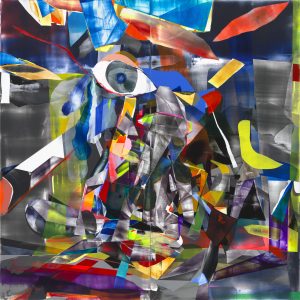Logging the Colors: More Art to Consider
Click on these images to see more examples of art that uses color to communicate experience. As you look at these pieces, what do the colors they feature communicate to YOU?

When world events suddenly shift our perspective and present overwhelming concerns, thinking like an artist can offer a way to creatively reflect on and process our days. Use the art, videos, and ideas in this lesson concept to help students explore ways to visually articulate their experiences by considering the colors, objects, and materials they encounter throughout their days.
When world events suddenly shift our perspective and present overwhelming concerns, thinking like an artist can offer a way to creatively reflect on and process our days. Use the art, videos, and ideas in this lesson concept to explore ways to visually articulate experience by considering the colors, objects, and materials you encounter throughout your days.
Artist Kristen Baker is known for her explosive and colorful paintings. In fact, color is an element that Baker uses to draw her daily experiences into her work.
“Most of the paintings are sort of a mix between color I see out in the world – you know, on a piece of clothing, or a billboard, and then I might be thinking of a Matisse painting…To me, it makes sense to bring them all together because that’s how I’m experiencing the world…I’m constantly logging these colors and bringing them together in a different way.”
This work, titled The Prig, which references Cubist collage was made with trowels, palette knives, and squeegees on sheets of polyvinyl chloride (PVC ). Baker builds her bright glossy surfaces by outlining each mark and shape with torn tape and filling in the interior. The forms are layered and sometimes scraped away to reveal the colors underneath. Her fractured images have a textural, hand-made quality that emphasizes the materiality of paint and also a synthetic, virtual quality like 3-D digital imaging.
Click on the image to take a closer look at Baker’s use of color.
American contemporary artist Kristin Baker discusses her work, process, and inspiration. She ends with a brief description of The Prig (2009), which resides in VMFA’s collection.
Click on these images to see more examples of art that uses color to communicate experience. As you look at these pieces, what do the colors they feature communicate to YOU?
Click on these images to see more examples of art that uses color to communicate experience. As you look at these pieces, what do the colors they feature communicate to YOU?
Like Kristen Baker, Radcliffe Bailey’s work is rooted in his lived experience as it relates to larger historical narratives. For Bailey, history and objects that connect to history are key to his selection of materials for his artwork. He looks for materials with multiple associations so that the artwork can spark an open-ended conversation with a viewer.
“My way of looking for materials or really materials that can speak…and it’s always easier, better when I can find an object that has an historical meaning, is beautiful, and has two or three different meanings…often I feel as if I’m trying to do work that doesn’t say just what I want it to say, but what other people want it to.”
While often rooted in personal experiences and family history, Bailey’s artwork often suggests larger narratives of the African American diaspora. Bailey’s own forbearers escaped slavery by the Underground Railroad, on which the North Star often served as a guiding beacon. Vessel brings together an array of found materials tied to ideas of displacement and migration: rustic French grape-harvesting baskets filled with crushed glass; a weathered shipping tarp embroidered with star constellation, black Civil War troop regiment numbers, and a map of states adjacent to the Mason-Dixon line; and an antique toy ship bearing an African sculpture, evoking the Middle Passage and a protective ancestor figure.
Click on the image to take a closer look at and see other views of Vessel.
Artist Radcliffe Bailey talks about his artistic process and what he hopes his art conveys. Come see "Vessel" in VMFA's permanent collection.
Click on these images to look at other works by artists who carefully choose materials and objects, placing them in combination with one another to communicate ideas and experiences. How do these objects and materials speak to YOU?
Click on these images to look at other works by artists who carefully choose materials and objects, placing them in combination with one another to communicate ideas and experiences. How do these objects and materials speak to YOU?
Challenge students to “log the colors” of one week out of the classroom, capturing colors with a digital camera, phone, or simply a set of crayons. Journal about the experience associated with each color. Set a goal to log at least 4 colors each day!
Challenge students to gather “materials that speak” about each day of their week. Choose objects and materials that may have more than one meaning or association. Document the objects and materials with a digital camera or phone and journal about the experience or ideas associated with each object.
Challenge students to digitally present combinations of the colors, objects, and materials they’ve “collected” to evoke their experience living through this particular moment.